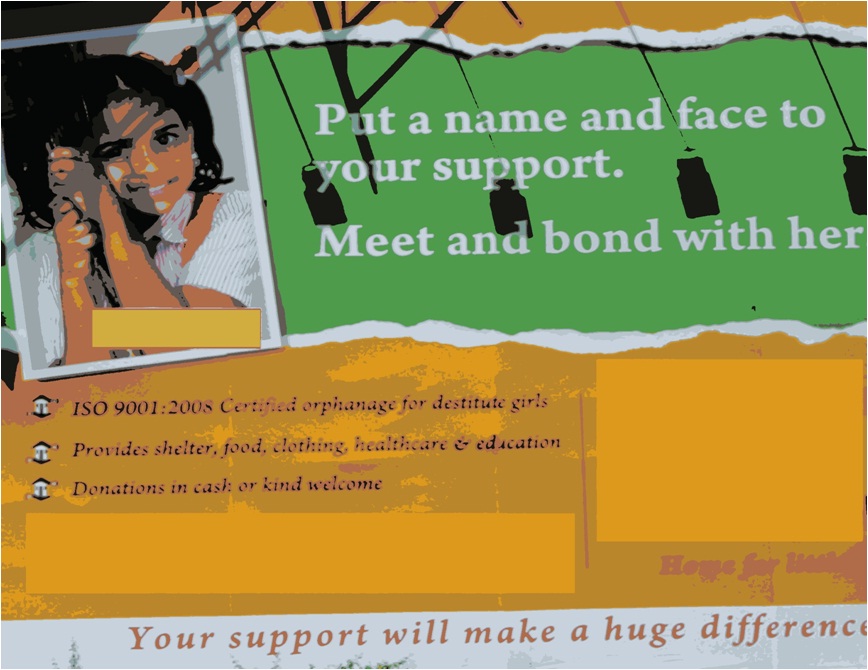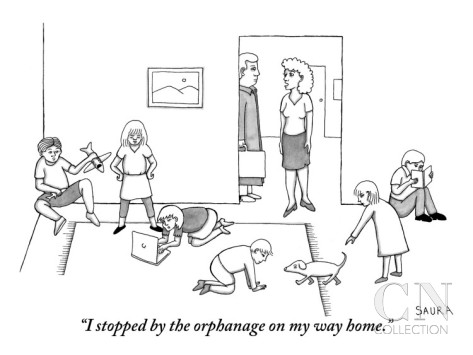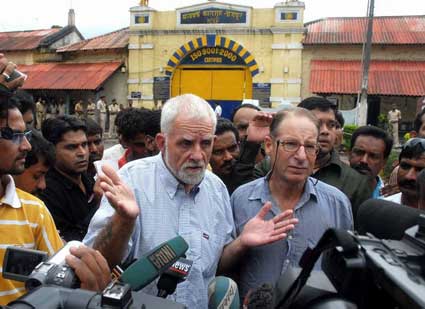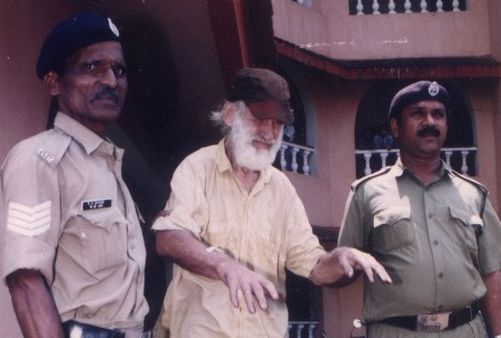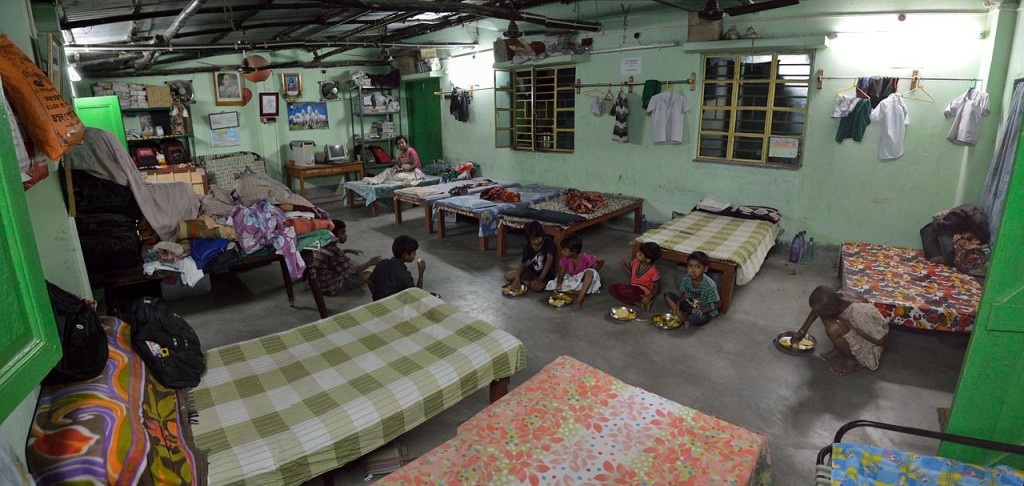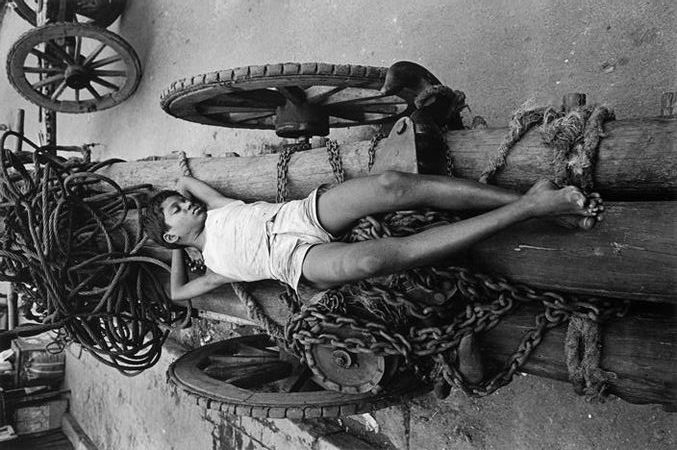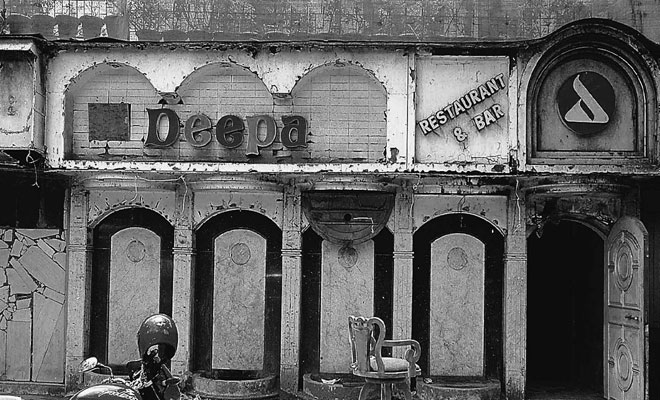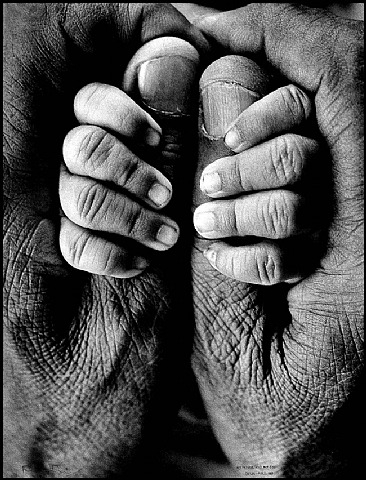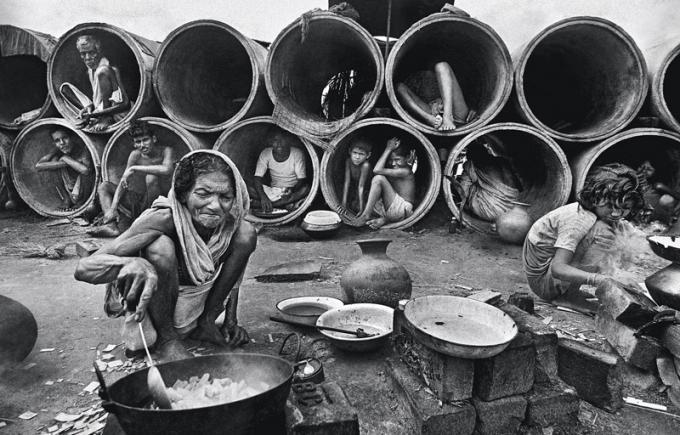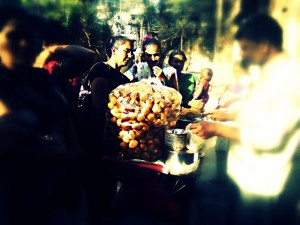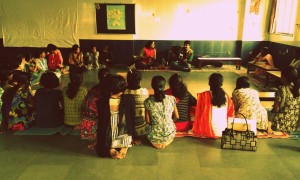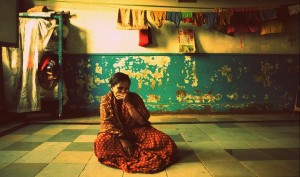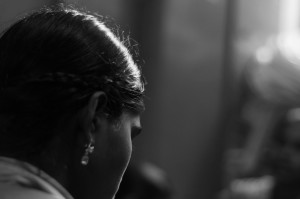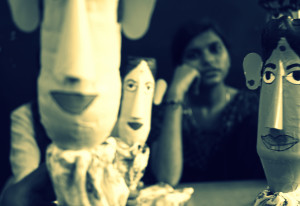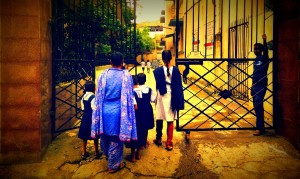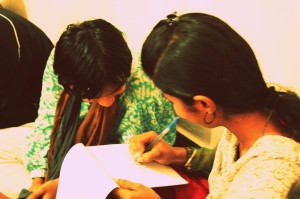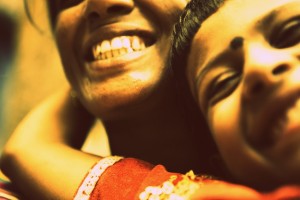"Safety and security don't just happen; they are the result of collective consensus and public investment. We owe our children, the most vulnerable citizens in our society, a life free of violence and fear."
- Nelson Mandela
Drawing some parallels……
I. The Hoarding That Signaled Danger
About six months ago, at two locations in Mumbai, we saw a giant size hoarding which was essentially a fund raising advertisement by an NGO for its Children’s Home. The advertisement disturbed us on many counts. It disclosed the facial identity of a child. It mentioned her real name and age. What disturbed us particularly was the following quote used as copy on the hoarding:-
“Put a name and face to your support. Meet and bond with her.”
“Put a name and face to your support. Meet and bond with her.”
We are living in a world where innumerable child sex predators are operating in online and offline spaces, who are trying every trick in their book to get access to children for purposes of exploiting them sexually. Police agencies like Interpol and Europol are working day and night for years together to keep pace and track down and bust the criminal rackets of child sex predators.
In this context, in the reality of the world that we live, the above advertisement reads like a clear invitation to such sinister criminals to pay some money by way of donations and get easy access to child victims.
That the advertisement was misguided and in bad taste is beyond question. What worries us is that this is hardly an isolated incidence. It is just a symptom of a larger malaise.
That the advertisement was misguided and in bad taste is beyond question. What worries us is that this is hardly an isolated incidence. It is just a symptom of a larger malaise.
II. Great Expectations
Recently two members of a Child Welfare Committee (CWC) shared their concerns with us over the manner in which a certain Children’s Home approached them with a peculiar request.
The Home in case has been operating for more than 20 years. Its social worker was seeking permission for three of the Home’s resident girls to spend their vacation at one of their firangi (local slang for foreigner, mostly of a Caucasian origin) volunteer’s residence.
When the CWC Chairperson probed further seeking more details about the volunteer the social workers became quite furious and asked, “How can you doubt the intentions of firangi volunteers? They have been so helpful and generous to the children in our Home. And all that without expecting anything in return! Is it not their kindness that they want these girls to share their residence on holidays?”
Fortunately, the CWC Chairperson was rightly circumspect about the whole proposal and did not yield to the outburst.
Soon the firangi volunteer herself approached the CWC and in a confrontational tone started blaming the Committee for acting ‘unnecessarily stubborn.’ “I only want to help those poor girls get an experience in family life,” She said.
Professionals in the field of child protection must realize that what the CWC was doing was exercising a bare minimum caution that it is supposed to observe. We must be reassured that the CWC remained undaunted and stuck to its demand for scrutiny.
Professionals in the field of child protection must realize that what the CWC was doing was exercising a bare minimum caution that it is supposed to observe. We must be reassured that the CWC remained undaunted and stuck to its demand for scrutiny.
With full respect to the kindness of human beings and the element of altruism, there is a need to highlight the growing and sinister trend of child sex predators who are trying to access vulnerable children under the garb of volunteerism and donations.
Orphanage Tourism is one of the latest and most insidious trick of the travelling sex offender- one that we must all be wary of and safeguard our most vulnerable children from.
III. The Case of the Swiss Couple
A decade and half ago, a Swiss husband and wife couple was arrested in The Resort, a hotel on the Aksa beach of Mumbai for sexually exploiting several children from the nearby slums and making pornographic films on them. It was alleged that the couple had been visiting India and operating from that hotel for the previous seven years. Their modus operandi was simple - offer plenty of gifts (such as clothes, chocolates etc.) to those children. It was discovered during the investigation that they were involved in similar offences in Thailand and Sri Lanka, as well.
IV. Anchorage: The Colaba Orphanage Sex Tourism Case
In 2001, yet another case was detected in Colaba, Mumbai in which British nationals and former officers of the Royal Navy, Allan Waters and Duncan Grant had started an orphanage by the name of Anchorage Home. The residents of the Home were street children between the age 8 and 18 years. Duncan Grant set up the Anchorage Shelter Home in Mumbai in 1995 that Alan Walters visited frequently. (source:- Childline).
The investigation revealed that “Grant and Walters were sexually abusing the children under their care and that a large number of foreign child sex offenders were regularly visiting the shelter and taking the children to Goa where the children were also being sexually abused,” Another accused was the manager of the Home, Mr. William D’Souza, an Indian national and a former pimp for sex tourists visiting Mumbai.
In March 2006, a Mumbai Sessions court sentenced Grant and Waters to six years in prison on the charges of sodomy and sexually abusing five minor boys. They challenged the conviction in the Bombay High Court, which acquitted them in 2008.
However in 2011, Supreme Court restored the conviction and the sentence. Grant and Waters have since completed their sentence and returned to the UK where they have been put on the Sex Offenders Register. Apparently, Grant had been on the radar of the British law enforcement for over 20 years.
V. Goa Gurukul & Father Peats
In the year 2005 Freddy Peats died in the jail while undergoing the longest imprisonment of Indian history for sexually exploiting several children, making pornographic material on them and making them available for other foreign tourists in the state of Goa under the garb of running a shelter home-cum-orphanage and inviting ‘volunteers’. He would inject the groin of the child victims with steroids to stimulate erections. He was arrested in 1991. His accomplice a New Zealander E.C. McBride was extradited to India and sentenced with imprisonment for the same offence.
VI. The Kolhapur Orphanage Involved in Sex Trafficking
On Sunday 26 April 2015, Emmanuel Gaikwad was arrested by the Goa Police for trafficking to Goa some children between the age 9 and 14 years from an orphanage by the name of Our Father’s Home (OFH) located in Kolhapur. The OFH was run by Emmanuel Gaikwad along with a Korean missionary Ekuk Kim alias David.
The Deputy Superintendant of the Goa Police shared that the CWC Chairperson of Goa had mentioned that the operation of Our Father's Home (OFH) in Kolhapur was illegal.
A UK national Timothy Geddens was also booked in the case.
Geddens, a Winchester University graduate was a music teacher at Glaitness School, U.K. and had declared that he was going to Goa to teach music. Geddens also claimed that he was a music therapist. 3 OFH children were found in his possession in Goa.
The DNA report states that the Kolhapur CWC was not aware of the existence of OFH. None of these children were moved from Kolhapur to Goa and given in the custody of Geddens in Goa with the permission or knowledge of the CWC Kolhapur or CWC Goa (which is mandatory as per the Juvenile Justice Act 2000). The parents of the children were also not aware of this shift.
(source: - DNA, 25th April 2015)
VII. The Altruist Tourists
In the last 6 months we received two separate calls requesting our organization Prerana to allow tourists to visit our shelter facility and interact with the resident children there. Both callers were tour operators. As we did not promptly grant their request but kept asking more questions, they kept promising us that the tourists would give attractive gifts to the children if we allow them to visit our shelter and interact with the children.
The tour operators tried every negotiation tactic to make us believe that we should consider ourselves fortunate to get such kindhearted foreign tourists who in spite of having travel led from the faraway lands to India wanted to spend their time intermingling with some poor and orphan children instead of going to other recreation points. They further tried to lure us by indicating that if the tourists felt happy then they would also give attractive donations to the organization.
Those calls reminded us of our experiences in Cambodia on a study tour organized by ADMC Foundation earlier this year where we had the opportunity to interact with some amazing organizations and frontline child protection workers.
VIII. Orphanage Tourism in Cambodia
Cambodia is a land of scarred childhoods. It is just emerging from a brutal past in which innumerable children were orphaned and subjected to heinous forms of violence, harm, and neglect. The ILO report of 2006 finds over 313,000 Cambodian children caught in the worst forms of exploitation including drugs and prostitution.
A UNICEF research in 2007 reported that of the 40,000 to 100,000 individuals being exploited in sex work in Cambodia, around 35% are minors.
The ECPAT Report on Status of Commercial Sexual Exploitation of Children in Cambodia mentions that while exact statistics were difficult to access, local and international research has shown widespread menace of child pornography and travelling child sex offenders. In the absence of any robust path to economic development it appears to be relying upon tourism and an uncontrolled population of expats. The situation is a fertile ground for the growth of orphanage tourism.
There are reports of mushrooming of innumerable orphanages all over popular tourist locations in Cambodia where routinely foreign tourists from the developed countries visit, stay, and intermingle with the children… apparently an innocent activity.
Cambodian child rights organizations like M’lop Tapang & APLE whom we visited maintained that the so called orphan children in many of these orphanages are actually not orphans at all. Many orphanage owners pay a rent or fixed amount to the parents to take away their children and keep them in their orphanages. These children are made easily available to the sex offendors.
It was our own direct experience in the major cities in Cambodia that most tour operators and hotels offer orphanage tours in their packages.
We witnessed several tourists working out the itinerary of visiting such orphanages as the first thing after checking in. The introductory leaflet kept at Reception counter of some of the hotels unfailingly devotes a paragraph on such tours. The orphanages in return get some donations against this access. It is not just hotels, the tuk-tuks (rikshaw) drivers in cities of Cambodia will always find an opportunity to ask every tourist if they would ‘want’ access to girls or boys by visiting an orphanage. UNICEF has now joined the campaign against orphanage tourism in Cambodia.
IX. Being ChildSafe
The ChildSafe network, a global child protection system, conceptualized and established by Friends International undertakes child safety audit of hotels and Tuk-tuks. They sensitize the staff and issue ‘thumbs up’ stickers that certify that they adhere to the principles of the ChildSafe movement. It was always heartening to view a ChildSafe sticker as one walks into a hotel or boards a tuk-tuk. However as we observed, it is far from a fool proof system. Despite having been branded ChildSafe, some hotels and tuk-tuks have no qualms in flouting the principles.
In creating the ChildSafe network, the activists have clearly succeeded in initiating a public dialogue that brings to light pertinent issues related to orphanages such as: Are we fabricating orphans and making a business out of them by setting up such orphanages? Are we, instead of creating safe spaces for children actually creating safe havens for the child sex predators to exploit children under the garb of “voluntary community service?
There is no doubt that activists working in organizations like Friends International and M’lop Tapang started many innovative interventions to protect vulnerable children of Cambodia, give them livelihood skills and to offer to them the choice of safe and sustainable alternative livelihoods. However, when it comes to enforcing child protection it is not always possible for the civil society organizations to intervene in establishments owned by private sector.
Kudos to the civil society organizations like Friends International, APLE and M’lop Tapang who are fighting orphanage tourism in order to protect Cambodian children from sexual exploitation and trafficking. They deserve special recognition for incorporating progressive and path-breaking interventions despite the unfavorable politico-economic situation.
X. The Hell Holes
There is ample evidence to suggest that orphanages are being used as the most unsuspecting fronts for the organized reprehensible crime of child sex tourism. Foreign nationals are involved in setting them up and running most of them.
Often a local manager is recruited and placed as a ‘fixer’ (the contact person to ’fix’ the regulating government bodies).
The access to these orphanages looks almost exclusively limited to Caucasian foreign nationals from the developed world. The reports of Europol and Interpol mention that these child sex predators commonly use the terms ‘hunting their prey’ (the children) in their internal communication. These police agencies have also shown that the crime syndicates of traveling child sex offenders keep, share, and compare with other similar offenders their photo collections of hundreds of the children they have 'hunted down' and the description of the process of 'hunting'. Some even have the temerity to go a step further and claim that there is nothing wrong in having sex with children.
XI. The Vulnerable Indian Child
In a country like India where over 1,00,000 children go missing each year, (source:- bba) where every 3rd minute a child gets trafficked, where infant mortality is the highest in the world, where close to 13 million children eke out living in the informal labor markets, where 3,00,000 young ones are involved in organized beggary (source:- wikipedia) and where 4,00,000 children don’t have a roof over their heads and families to support them there is no dearth of unprotected children vulnerable to such predators.
XII. The Business of Charity
Starting an orphanage seems to have earned some cultural status and hence the orphanage founders are felicitated and there is a general perception of them as ‘people who cannot do wrong’. Often their financial well being depends directly upon the number of children living in their shelters.
Hence keeping captive orphans in their shelter in big number is a precondition of their own survival and career of many so called social workers specialized in setting up and running orphanages.
There is no cognizance taken of the basic fact that an orphanage may not always be a suitable place for a child in need of care and protection to live and grow.
Equally irresponsible are those patrons who blindly donate to orphanages. Some orphanages strategically locate themselves close to highly worshiped religious places. Their donation diaries are filled with outpourings of instant charity from desperate devotees who flock to these places.
One common form of charity is to sponsor breakfast, lunch, and/or dinner or parties for the orphans.
The orphanage managers take the donation and block a date in their diary in front of the donors. The diaries get full so fast that very often multiple diaries are maintained for the booking. Why would such orphanages try to locate the parents or guardians of the children and to restore the children in their custody?
There are other orphanages, and their number is rising, who are ill-reputed for using orphans only to show to their donors as to how many children they have converted to their religion. Often children in their custody who are completely dependent on them for survival get converted without a choice.
XIII. The Need for Macro Level Provision for Data Sharing
Many developed countries have set systems in place to ensure that people who offer to volunteer have to pay a fee and get a police certification of not having committed any crime against children.
Initiatives like the ‘International Child Protection Certificate’ issued by the UK Criminal Justice Department to volunteers looking to contribute their skills and time working with children in other countries are steps in the right direction. The ICPC allows international schools and other organisations who work directly with children to be able to access the criminal conviction history of UK citizens and those who have resided in the UK for any period of time. This will enable overseas schools and other organisations to assess an applicant’s suitability to be working with children.
Initiatives like the ‘International Child Protection Certificate’ issued by the UK Criminal Justice Department to volunteers looking to contribute their skills and time working with children in other countries are steps in the right direction. The ICPC allows international schools and other organisations who work directly with children to be able to access the criminal conviction history of UK citizens and those who have resided in the UK for any period of time. This will enable overseas schools and other organisations to assess an applicant’s suitability to be working with children.
Many countries maintain and make publicly available directories called ‘Sex Offenders’ Registers’ which have entries of names and photographs of persons with history of sexual offences. These procedures go a long way in ensuring that the child beneficiaries in child welfare organizations, shelters and orphanages are not accessed by child sex offenders under the garb of volunteers, duty bearers, or care takers.
This system is obviously based upon the experience of these countries of the sinister attempts by the child sex predators.
Unfortunately in India ‘background check’ or ‘police verification of volunteers and candidates for job’ in child welfare services is not mandatory. Some transparent and progressive organizations in India have started a good practice of getting the background check done through the local police stations.
All these measures are inherently weak as there is no system in India to keep a data bank of such criminals and the verification remains limited at the most to the data of the specific police station only.
We need a comprehensive and constantly updated data maintenance and data sharing system in order to make the provisions of police verification and sex offenders registers effective. Until that happens children in shelter facilities will continue to remain dangerously exposed.
As an interim measure the un-scrutinized visitors, both local and foreign seeking access to children in the name of donating, charity, volunteering or tourism must be immediately blocked from getting that access. Homes that operate in ‘secrecy’ as mentioned in the beginning of this article must be closely monitored not only from the point of view of ensuring child safety but also for their legal status in terms of registration. Merely indulging in reactive measures once an expose occurs does not reverse the damage caused to the children.
As an interim measure the un-scrutinized visitors, both local and foreign seeking access to children in the name of donating, charity, volunteering or tourism must be immediately blocked from getting that access. Homes that operate in ‘secrecy’ as mentioned in the beginning of this article must be closely monitored not only from the point of view of ensuring child safety but also for their legal status in terms of registration. Merely indulging in reactive measures once an expose occurs does not reverse the damage caused to the children.
XIV. The Dignity of the Child
Shelter homes are facilities meant to restore the dignity of the children who are vulnerable. Privacy is an important prerequisite of it. Children are not exhibits! The unscrupulous orphanage owners who “display” the children for mobilizing donations should be held accountable for the wrongs. Exposing the face and such other identity of a child in need of care and protection or a child in conflict with law who are before the juvenile justice system is not just an offence under Section 21 of the Juvenile Justice Act 2000 but is also a violation of the child’s rights and dignity.
Looking after the well being of such children is entirely the inescapable legal responsibility of the State and the civil society. It is not an optional act of charity.
XV. Where India Can do Better for Its Children
We in India are much better placed in terms of our legal institutional framework and resources. We already have laws for child protection in place. We have clearly defined minimum standards of care and protections in the Rules of the Juvenile Justice Act 2000. We have guidelines for registrations and licensing of child care institutions. We have a Child Welfare Committee (CWC) whose aim is to protect children. However, our record on most indicators of child victimization in shelter homes is still enormously bad.
This is certainly not, as some people like to project, due to our sheer huge population. Remarkably however many smaller and poorer countries have shown a better and praiseworthy performance on the child protection front than India.
XVI. Volunteerism’ or Volupteerism?
Against what we observed in Cambodia and what has been happening all over the world with respect to victimization of children for sexual purposes through tourism and under the garb of orphanages/shelter facilities the case mentioned in the beginning of this article indicates a sinister plan.
Would it be wrong to conclude that in plain words the ad mentioned above says, “give us funds and we give you access to unprotected children.”
As it has already happened in Cambodia and has been observed in parts of India it raises a scary question – Is it ‘volunteerism’ or volupteerism?
